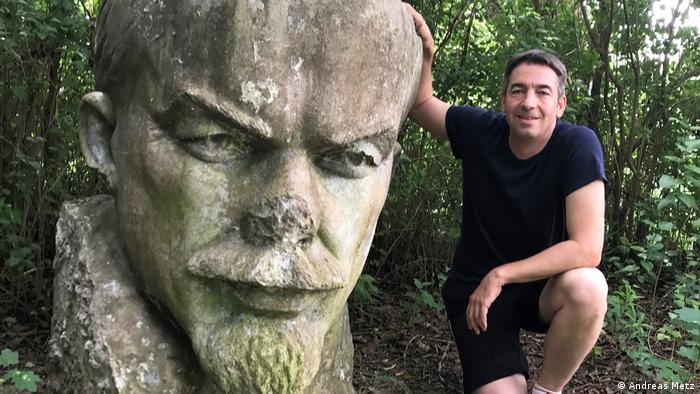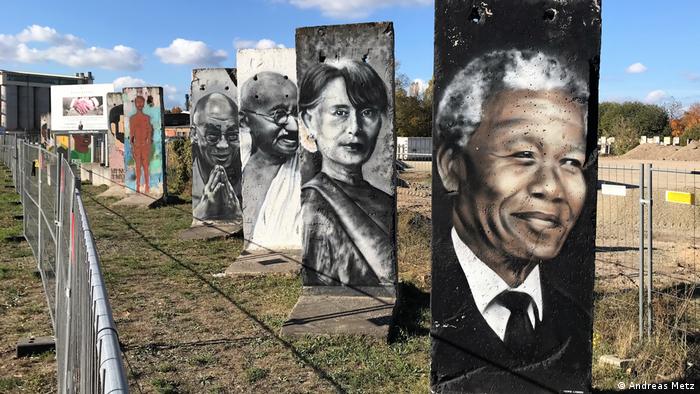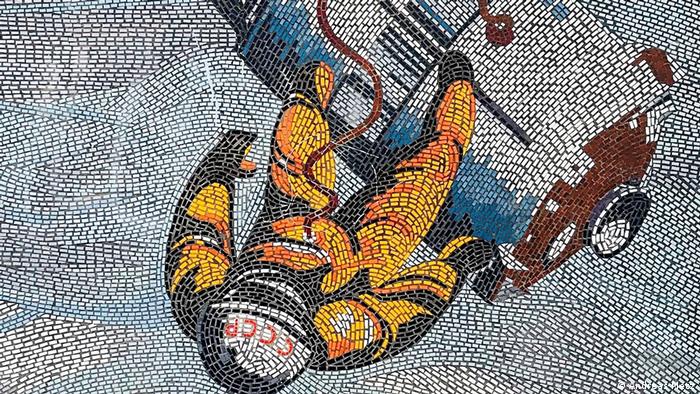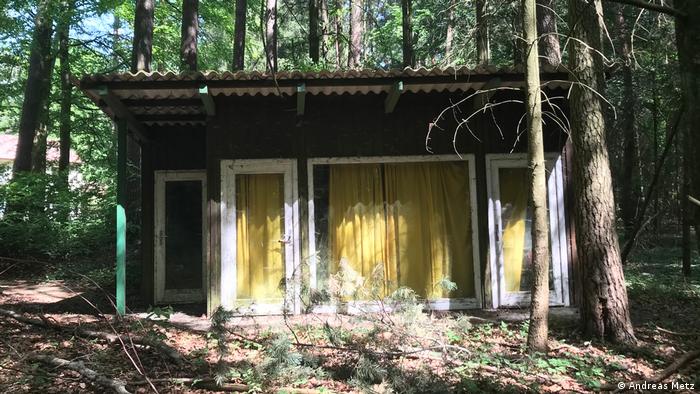Almost three decades after the accession to the Federal Republic of disappearance of the traces of the GDR, more and more. Therefore, Andreas Metz has opened up, dilapidated Department stores and hidden of Lenin busts to hold.
-

East Places: The hidden relics of the GDR
A race against time
Photographer Andreas Metz has traveled in the past three years, Eastern Germany, buildings and objects from the GDR and a hold time, which are threatened by decay and demolition, as these neon signs in Leipzig. To see his pictures are now in the image band “Ost Places – From the Disappearance and again in the GDR to find.”
-

East Places: The hidden relics of the GDR
‘Encouraging people to visit these places
“The book should also be a bit of a guide, which induces people to visit these places and to go on their own journeys of discovery,” says photographer Merz. The Restaurant “Seerose” in Potsdam, Germany, opened in 1983, is also in operation today. More than 70 futuristic concrete shell buildings such as these, designed by a civil engineer Ulrich Müther, there was in the GDR. In the meantime, many had been stripped.
-

East Places: The hidden relics of the GDR
Forgotten Lenin in Brandenburg
This tarnished bust of Lenin Andreas Metz in Brandenburg, the Prince of the mountain was hidden behind dense bushes. He suspected that the bust of the deduction of near to station Soviet troops after the turn has been forgotten.
-

East Places: The hidden relics of the GDR
The East, with the wheel exploring
For “Eastern Places” Merz traveled to the new länder without a car, only using public transport and especially the wheel. “When you put the bike on the road, has a more intense perception of places, because you can be relatively slow, but very flexible on-the-go,” he says. This picture shows the entrance to the nuclear power plant of Rheinsberg in Brandenburg, which was closed in 1990.
-

East Places: The hidden relics of the GDR
Not only the border and the Stasi Terror
“I would like to draw a multifaceted picture of the GDR and life in the GDR. Not only the negative aspects of show – border, Stasi prisons – but also in everyday life”, describes photographer Metz’s concerns. This elephant slide from the DDR-time, he found on a Playground in Leipzig, Germany.
-

East Places: The hidden relics of the GDR
Propaganda for the nuclear power
The huge mural “The peaceful use of nuclear energy” now stands on a secluded Meadow in Thuringia. Earlier it belonged to a mining facility, the uranium for the Soviet atomic bombs was promoted. The GDR was the world’s fourth-largest uranium producer, 231,000 tons were taken out of the earth, thousands of workers were exposed to harmful radiation.
-

East Places: The hidden relics of the GDR
Cable Plant-Köpenick
This is the shot of Metz, in a former cable factory in Berlin-Köpenick. Once 1,600 people worked here in the mid-1990s, the operation was shut down. Today, graffiti cover the walls and ivy überrankt the metal pillar. There are plans to build on the Site on the river Spree for up to 1,000 apartments, just a few, under monument protection standing buildings should be preserved.
-

East Places: The hidden relics of the GDR
GDR-cinema-culture
The Kino International on Karl-Marx-Allee in Berlin was opened in 1963. Served in GDR times, the prestigious about it as a premiere cinema with numerous films in the state production company DEFA were here performed for the first Time, international films such as “Dirty Dancing” celebrated here is her debut GDR. Even today, the cinema is in operation.
-

East Places: The hidden relics of the GDR
The garden gazebo of the Secretary-General
This unassuming, semi-derelict garden any so – called “dacha”-but from the former GDR Secretary General Erich Honecker, is not gazebo. It is located on the grounds of the forest settlement Wandlitz. On the site of the SED lived-Elite, shielded from the Rest of the population in the GDR was very luxurious conditions.
-

East Places: The hidden relics of the GDR
The wall as an art object
Most of the items and buildings, has held photographer Metz have so far found little attention. However, some known motifs were of course missing all the walls. This painted remnants of the wall photographed Metz in Brandenburg, Kleinmachnow, between Berlin and Potsdam.
Author: Mara Bierbach
-

East Places: The hidden relics of the GDR
A race against time
Photographer Andreas Metz has traveled in the past three years, Eastern Germany, buildings and objects from the GDR and a hold time, which are threatened by decay and demolition, as these neon signs in Leipzig. To see his pictures are now in the image band “Ost Places – From the Disappearance and again in the GDR to find.”
-

East Places: The hidden relics of the GDR
‘Encouraging people to visit these places
“The book should also be a bit of a guide, which induces people to visit these places and to go on their own journeys of discovery,” says photographer Merz. The Restaurant “Seerose” in Potsdam, Germany, opened in 1983, is also in operation today. More than 70 futuristic concrete shell buildings such as these, designed by a civil engineer Ulrich Müther, there was in the GDR. In the meantime, many had been stripped.
-

East Places: The hidden relics of the GDR
Forgotten Lenin in Brandenburg
This tarnished bust of Lenin Andreas Metz in Brandenburg, the Prince of the mountain was hidden behind dense bushes. He suspected that the bust of the deduction of near to station Soviet troops after the turn has been forgotten.
-

East Places: The hidden relics of the GDR
The East, with the wheel exploring
For “Eastern Places” Merz traveled to the new länder without a car, only using public transport and especially the wheel. “When you put the bike on the road, has a more intense perception of places, because you can be relatively slow, but very flexible on-the-go,” he says. This picture shows the entrance to the nuclear power plant of Rheinsberg in Brandenburg, which was closed in 1990.
-

East Places: The hidden relics of the GDR
Not only the border and the Stasi Terror
“I would like to draw a multifaceted picture of the GDR and life in the GDR. Not only the negative aspects of show – border, Stasi prisons – but also in everyday life”, describes photographer Metz’s concerns. This elephant slide from the DDR-time, he found on a Playground in Leipzig, Germany.
-

East Places: The hidden relics of the GDR
Propaganda for the nuclear power
The huge mural “The peaceful use of nuclear energy” now stands on a secluded Meadow in Thuringia. Earlier it belonged to a mining facility, the uranium for the Soviet atomic bombs was promoted. The GDR was the world’s fourth-largest uranium producer, 231,000 tons were taken out of the earth, thousands of workers were exposed to harmful radiation.
-

East Places: The hidden relics of the GDR
Cable Plant-Köpenick
This is the shot of Metz, in a former cable factory in Berlin-Köpenick. Once 1,600 people worked here in the mid-1990s, the operation was shut down. Today, graffiti cover the walls and ivy überrankt the metal pillar. There are plans to build on the Site on the river Spree for up to 1,000 apartments, just a few, under monument protection standing buildings should be preserved.
-

East Places: The hidden relics of the GDR
GDR-cinema-culture
The Kino International on Karl-Marx-Allee in Berlin was opened in 1963. Served in GDR times, the prestigious about it as a premiere cinema with numerous films in the state production company DEFA were here performed for the first Time, international films such as “Dirty Dancing” celebrated here is her debut GDR. Even today, the cinema is in operation.
-

East Places: The hidden relics of the GDR
The garden gazebo of the Secretary-General
This unassuming, semi-derelict garden any so – called “dacha”-but from the former GDR Secretary General Erich Honecker, is not gazebo. It is located on the grounds of the forest settlement Wandlitz. On the site of the SED lived-Elite, shielded from the Rest of the population in the GDR was very luxurious conditions.
-

East Places: The hidden relics of the GDR
The wall as an art object
Most of the items and buildings, has held photographer Metz have so far found little attention. However, some known motifs were of course missing all the walls. This painted remnants of the wall photographed Metz in Brandenburg, Kleinmachnow, between Berlin and Potsdam.
Author: Mara Bierbach
Deutsche Welle: you were born in Frankfurt am Main, grown up in the West. Whence comes to you as a “Wessi” fascination with the East and its forgotten places?
Andreas Metz: it has begun in the school, in 1987, when I was able to drive at the age of 17 on a study trip in the GDR. And then I was in 1989, shortly before the fall of the wall in East Berlin. With the Opening of the Iron curtain, there was a Chance of this unknown part of Germany and Europe to become closely acquainted with, that I found exciting. Later, I sat in the study with the GDR and Eastern Europe apart.
Her picture book “Ost Places – From the Disappearance and again in the GDR” find preserved Remnants of the GDR, from factories and cinemas to Mini-kiosks and villas, but also Lenin busts, Soviet Propaganda murals, wall pieces, trabants still shows. Whence came the idea?
I live since 15 years in the East of Berlin, too, am often in the countryside in Brandenburg and the other new länder, on-the-go. In the process, I realized that many images, you can do just yet so would, in some time, because this is very much the fall of the wall disappears after 30 years. For example, the typical GDR Kaufhalle, which was in the neighborhood. Which has been demolished recently. The pictures I made, served at the beginning of the private documentation. But then I quickly had so many interesting pictures that I said it must actually be a book.

Where the GDR elite athletes sports training centre in Kienbaum, Brandenburg, have trained:
The book’s title alludes to the term “Lost Places” – he describes places that have historical importance, but yet hardly any attention is paid. In fact, many of the places that you have been threaten to disappear completely. Would you wish that all your Eastern Places in to be held?
It certainly can not be the goal, everything remains in place. Life consists of change and modernization, it is also important that you can develop further. But it’s gone now so a lot of that you should, perhaps, before any further demolition of the question: not Can you get the but perhaps, somehow, to lose this place and these stories forever?
Can you name some examples from your book?
The Potsdam data center is a very prominent example. There is the mosaic “The man conquers the cosmos”, which consists of different sub-motifs, and a total of perhaps a hundred meters long. Next to the garrison Church is reconstructed, which had been demolished after the Second world war. In some years, the data centre is to be demolished to make space for the complete new Church building. Reconstructing things from the right to the far Prussian time, at the same time buildings of the Ostmoderne from the GDR will be destroyed-time. I think that is very questionable. In Berlin was demolished, for example, the Palace of the Republic – a place that is very close to the time of history and the hundreds of thousands of GDR citizens positively in the memory and on the site of the city was reconstructed castle, with only a few people something to connect to.

DDR-art data center in Potsdam is An excerpt from the mosaic “The man conquers the cosmos”
What is the response of people in the GDR great on your project Ost Places? Your images differently than West Germans see this?
The photo selection for the book I made as a West German, with a lecturer, who grew up in the GDR. I think that has done the book very well, because our perception is sometimes very different. Motifs that were very special for me, were sometimes banal. And Vice versa, images that for me were not so remarkable have triggered something for you – any memories triggered. We met always in the middle.
Do you have a favorite photo among the East Places?
A special photo is definitely the mural “Peaceful use of atomic energy”, the very, very remote in Thuringia on a field. The image was originally attached to a building of the Wismut AG, which provided uranium for the Soviet atomic bombs. Many people have risked their health. To find this mural was very time-consuming. A lot of people in the area, I have asked knew nothing about it. This is an experience that I’ve made to travel again and again: That a lot of people not at all, or not at all perceived knew that it values the GDR protect-are relics in their immediate environment.

This gazebo is not about any country, but the of Erich Honecker, from 1971 to 1989, the Communist party General Secretary was
What kind of reactions do you want to achieve with your book?
I think we have three decades after the fall of the wall now, and perhaps the last Chance together for a revaluation of the turn and to come up with something more of the conversation – people from the East and the West, the young and the older Generation. There are experiences and Lessons learned from the DDR-time, are valuable, and we should use much stronger, to build a common Germany. It would make me very happy, if the pictures can give an impetus to this dialogue and help us to understand each other better.
Andreas Metz is a photographer and Journalist. He was born in 1970 in Frankfurt am Main and lives with his family in East Berlin. His image band “Ost Places – From the Disappearance and Again in the GDR” is in the publishing house “New life” appeared.
The questions Mara Bierbach presented.












